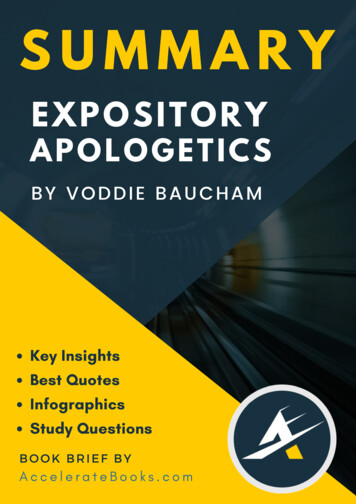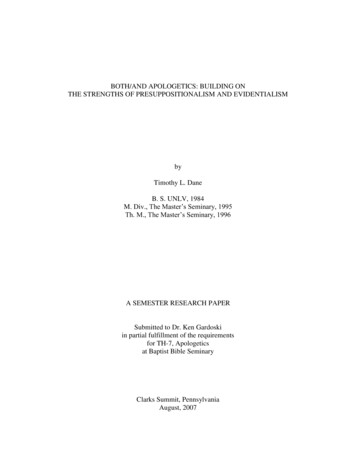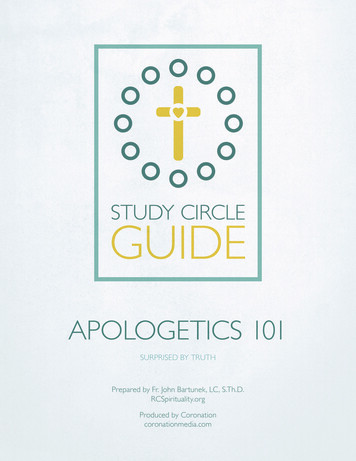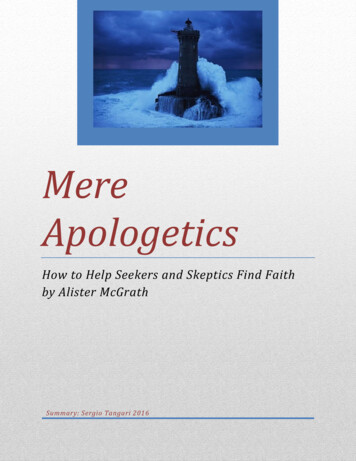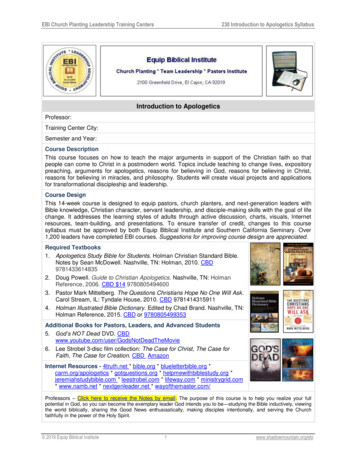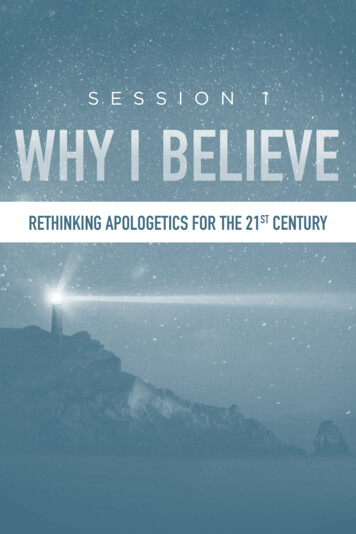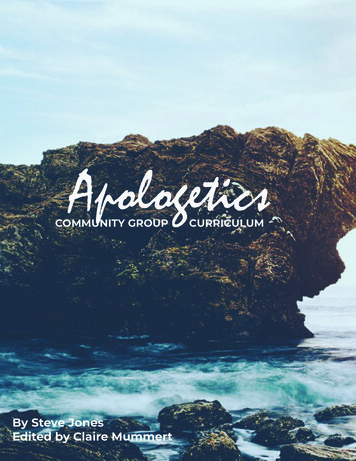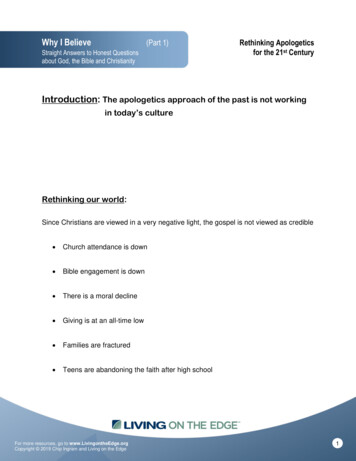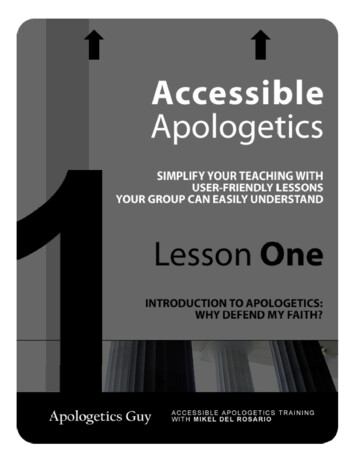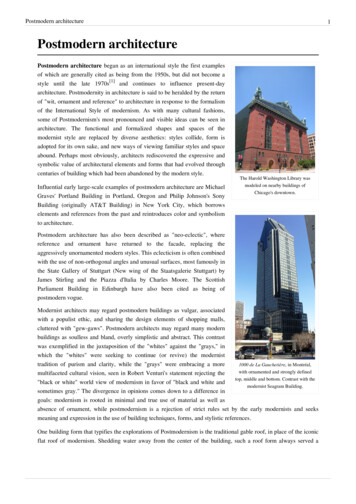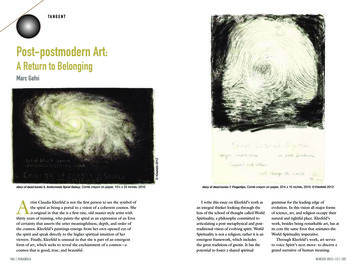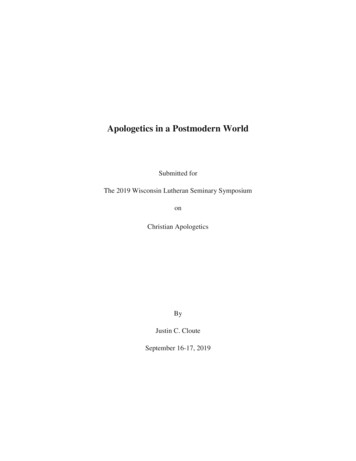
Transcription
Apologetics in a Postmodern WorldSubmitted forThe 2019 Wisconsin Lutheran Seminary SymposiumonChristian ApologeticsByJustin C. ClouteSeptember 16-17, 2019
Intro“Eventually, all things merge into one, and a river runs through it.The river was cut by the world's great flood and runs over rocks from the basement of time.On some of the rocks are timeless raindrops.Under the rocks are the words, and some of the words are theirs.I am haunted by waters.”– Norman Maclean, A River Runs Through ItLanguage Words Meaning. At the dawn of time—before the rocks—when the Spirit of God washovering over the waters, the Lord spoke into the void and called everything into existence. Then hespoke to his Triune-self to verbalize his gracious intent to create the crown of his creation: “Let us makemankind in our image, in our likeness ”1 In the very next words uttered by the Creator, he blessed theman and the woman and commanded them to “fill the earth and subdue it.” After the first coupledisobeyed God’s word and brought sin and death upon the world, the Lord God immediately promised tosend the Offspring of the women to crush the serpent’s head.Millenia later the Offspring was born and spoke words that were from God himself and imparted eternallife to those who accepted them.2 In some of the very last words recorded by the Apostle John, the onewho crushed Satan’s head and rose from the dead, promises, “Yes, I am coming soon.”3 From the firstchapter of Holy Scripture to the very last, God’s Word proclaims his will for mankind and reveals hisloving heart for humanity. There is a river running through it all. The words of God are the critical link,the crucial connection, the basis for a relationship between the holy and transcendent God and his earthlyand sinful creatures. They create faith, forgive sins, and comfort the dying.For this reason, it shouldn’t surprise us that the Word has always been under attack in one way or another.The philosophy of postmodernism challenges the very idea that words and language are able to conveymeaning and calls into question the fundamental assumptions of reason and logic. This essay will beginby 1) offering a few definitions of postmodernism and tracing how it sprouted from modernism inAmerica; 2) providing a brief overview of its philosophical genealogy; 3) looking at ways that thisphilosophy has affected our world and influenced our culture; and finally, 4) suggesting a few possibleapproaches to apologetics in a postmodern world.1Genesis 1:26a (NIV)2John 14:493Revelation 22:20b2
PostmodernismA DefinitionFor with much wisdom comes much sorrow; the more knowledge, the more grief (Ecclesiastes 1:18).The system only dreams in total darkness Why are you hiding from me?4What is postmodernism? You’ve probably heard the term thrown around so often that it’s hard not to rollyour eyes when you hear it. In its literal sense, “postmodern” is simply that which comes “aftermodernism.” However, the word has been applied in so many different areas that it has become almostimpossible to define.5 The French philosopher, Jean-Francois Lyotard, provided what has become aclassic definition of postmodernism. He writes, “Simplifying to the extreme, I define postmodern asincredulity towards metanarratives.”6 In other words, postmodernism is a distrust or suspicion toward anyoverarching explanatory story, such as science, political ideologies, religion, philosophy, and evenlanguage and reason itself. Some postmodernists would even go so far as to say that reason is just rhetoricin disguise. It is a disenchantment with the idea that there is one grand narrative that ties everythingtogether and can be used to help us make sense of the world.7 The following Wikipedia entry does anexcellent job of expanding this definition (using a definition from Wikipedia also serves as an example ofthe postmodern confidence in communal and collaborative truth):8 “Postmodernism is an intellectualstance or a mode of discourse that rejects the possibility of reliable knowledge, denies the existence of auniversal, stable reality, and frames aesthetics and beauty as arbitrary and subjective.”9 This definitionshows that postmodernism is concerned primarily with how we know what we know.10Postmodernism is not a set of systematic principles and beliefs that its adherents subscribe to. Instead it ismore of a philosophical movement, mood, or ethos. Myron Penner explains, “Postmodernity is acondition, or a set or attitudes, dispositions, and practices, that is aware of itself as modern and aware that4“The System only Dreams in Total Darkness,” by Aaron Dessner, Matt Berninger, and Bryce Dessner onThe National, Sleep Well Beast, 4AD, May 11, 2017.Ironically, the difficulty in defining “postmodernism” is itself an example of one the philosophy’s mainemphases: the indeterminacy of meaning56Jean-Francois Lyotard, The Postmodern Condition, quotation from the English translation by GeoffreyBennington and Brian Massumi (Minneapolis: University of Minnesota Press 1984)7Another French philosopher named Jean, Jean Baudrillard, describes how this plays out in society:Postmodernity “is said to be a culture of fragmentary sensations, eclectic nostalgia, disposable simulacra 7, andpromiscuous superficiality, in which the traditionally valued qualities of depth, coherence, meaning, originality, andauthenticity are evacuated or dissolved amid the random swirl of empty signals.” Quoted in the Oxford Dictionaryof Literary Terms, (Oxford University Press, 2015), 288.8Many modernists despise Wikipedia because it actually provides good and reliable information. In theirminds, definitions are supposed to come from a stuffy lexicographer working in a basement in Oxford, not fromcommon people (hoi polio) coming together on a wiki stored on the world wide Epistemological concerns3
modernity’s claims to rational superiority are deeply problematic.”11 For example, I am quite aware that itis a very modern approach to begin a paper on postmodernism by trying to describe it with formaldefinitions. At the same time, it is very postmodern to recognize that any definition I provide will fallshort of describing exactly what postmodernism is. It is also very postmodern to comment about this in aself-conscious way in an essay. 12While some would argue that the persuasive power of postmodernism began to wane in the nineties anddied when two airplanes crashed into the twin towers on September 11, 2001, rumors of its death seemgreatly exaggerated. Even if postmodernism itself is on its way out, we are still living with its effects. TheOxford English Dictionaries chose “post-truth” as their 2016 word of the year reflecting the currentpolitical climate with its “fake-news,” “alternative facts,” and the never-ending debate over topics likeimmigration policy, climate change, and gender labels. Whether postmodernism is simply a late form ofmodernism, or an entirely new movement is yet to be seen. In either case, it is helpful to look at howpostmodernism formed out of, or as a reaction to, modernism.A Reaction to ModernismThe spirit of modernism was conceived in the belly of the Enlightenment and nurtured on the optimism ofscientific advancement. The motto of the Enlightenment was “Have courage to use your own reason.”Reason unfettered from tradition, religion, and economic pressures promised to solve many of the age-oldproblems of humanity. Throughout the modern era there was this belief that the mind had unfilteredaccess to the material world, and that the world was rationally intelligible, and that humans could usereason and science to predict, control, and even manipulate the natural world. The British historian,Arnold Toynbee (1889-1975), famously commented, “We expected that life would become more rational,humane we expected that progress of science and technology would make mankind rich the coursewas set for an earthly paradise.”13 While this might sound like little more than Pollyannaish naivete, whenToynbee wrote these words, people really believed that “nothing’s gonna stop us now.”14 After all,medical technology and vaccines treated and eliminated many terrible diseases (at least for those in theindustrialized world), people were living more comfortable lives, and at the dawn of the 19th Centurythere had been no major wars between world powers for almost a hundred years.Until there was. By 1914 the Great War had taken the lives of millions of people in the most gruesomeways imaginable. It’s been said that the age of hope died in the trenches of Europe. Less than 20 yearslater, another war engulfed the world, and it introduced an unthinkable type of hatred fueled by anideology rooted in modernist principles. The racism that drove this hatred killed over 6 million in the11Myron Bradley Penner, The End of Apologetics: Christian Witness in a Postmodern Context, (GrandRapids, MI: Baker Academic, 2013), Kindle Loc 290.Postmodernism loves the “meta,” which is a postmodern term for the playground where the author isself-referential, self-conscious, and self-parodying. It draws attention to the fact there is always a layer ofcommentary and analysis going on.1213Arnold J. Toynbee, A Study of History, Volume 5, (Oxford University Press, 1961), p. 43.Starship, “Nothing’s Going to Stop Us Now,” No Protection, RCA Records 1987. Music video containsscenes from the movie “Mannequin” in a which a young artist makes a plastic model so beautiful that he falls in lovewith it. Not sure if this was intentionally postmodern, but its an example of simulacra. See also the movie, Her.144
Holocaust. This war was capped off by the introduction of the atomic bomb (an invention of modernscience) which annihilated millions of people with the push of a button.It took a while for all of this to sink in, and it didn’t immediately extinguish the optimism in America.After all, the West had come together to defeat a clear and definable evil. It is understandable that therewas a reason to celebrate. Furthermore, technology continued to make life more comfortable. Computersless powerful than the one in your pocket may have taken up entire rooms, but they promised a futurewhere mathematical exactness could be applied to real life problems. Advances in science and medicinealong with the spread of democracy led many to envision a society where peace would be widespread andlife expectancy would continue to push the limits of what had previously been considered possible. In apaper delivered to a pastor’s conference, Steven Degner gave a personal perspective: “I grew up in the1950’s and 60’s. We lived on the tower of modernism and watched it being built around us. We stood inawe of science and technology. The bright minds that gave us aluminum, TV dinners, and rockets headingfor the moon were the wonder kids who we hoped would engineer a new world of peace andprosperity.”15 It seemed that things were good and only going to get better.Then another war in Vietnam divided our nation. A new generation grew tired of the capitalistic dream towork hard and consume more. Instead they “tuned in and dropped out.” The nuclear threat once againcame to the surface as tensions rose between the US and the Soviet Union. Beneath the veneer of progressand hope, there was a growing sentiment of fear and pessimism.It’s one of the few recurring dreams I had as a child. A little boy, maybe 4 or 5, is riding his red RadioFlyer tricycle across the wooden floor of a huge gymnasium. It’s empty. There is the distinctive sound ofhis wheels rotating on a hollow wooden floor and echoing off the walls along with the soft jingle of hishandlebar bell. He is singing with a soft and high-pitched whisper, “Hush, little baby, don’t say aword ” The boy is so small, so tender, so content. Then there is a loud noise. The gym implodes andexplodes at the same time. Everything is white hot and burning – a nuclear bomb.Even though I had a peaceful and happy childhood, this dream reveals a disturbing undercurrent I hadpicked up in the world around me. This was the time of the “Second Cold War” (1975-1985). At schoolduring the day, children were taught how to neatly tuck their heads under their desks in case of a nuclearattack (as if the Formica top and aluminum shell would somehow protect) and at night families sat downwith a bowl of popcorn and watched the apocalyptic made-for-TV-movie, The Day After16, whichportrayed a nuclear holocaust in Kansas and Missouri. Beneath the surface of the modernist dream, therewas a suspicion that all of mankind’s greatest achievements might lead to total annihilation.In the scientific world the revolution that had taken place in physics in the early 20th century with specialrelativity, general relativity, and quantum mechanics rocked the foundations of science itself. Many beganto wonder whether the universe could still be viewed as a complicated machine whose workings wereuniform and predictable. The age-old question of the relationship between the mind and the world(matter) once again rose to the surface. Philosophy turned its focus almost entirely to epistemologicalquestions.17 How do we know what we know? What role does our mind play in interpreting the sensorySteven Degner, “Not Ashamed of the Gospel in a Postmodern Age,” WLS essay 6The Day After, (ABC television network, 1983)17In philosophy, epistemology is the study of how we know what we know and what we can really know.5
data in the world around us? What are the limits to our knowing? Is it possible to stand in a neutral placeof unbiased surveillance with the “doors of perception cleansed”18 and see the world as it really is? Thestage was set for postmodern theory to make inroads into popular American culture/consciousness.However, before we go any further, it may be helpful to back up and look at the origins of thisphilosophy.Philosophical GenealogyConceived in NihilismWhen I applied my mind to know wisdom and to observe the labor that is done on earth—people gettingno sleep day or night – then I saw all that God has done. No one can comprehend what goes on under thesun. Despite all their efforts to search it out, no one can discover its meaning. Even if the wise claim theyknow, they cannot really comprehend it (Ecclesiastes 8:16-17).The seeds of postmodern philosophy had already been planted in the world of academia about a hundredyears before Americans were watching movies about nuclear annihilation in middle America. Thebrilliant German philosopher and son of a Lutheran pastor, Friedrich Nietzsche (1846-1900), is famouslyremembered for announcing that “God is dead!” This announcement seems to have been more of anacknowledgement of the way the post-Enlightenment world had been operating and less of a triumphantproclamation. Nietzsche was like the passenger on an airplane who announced to the rest of thepassengers that the pilot had been pushed out of the cockpit - this thing is going down! In a famouspassage from The Gay Science, his fictional madman lights a lantern in the morning and walks into themarketplace. After being laughed at for asking where God was, the madman announces,God is dead. God remains dead. And we have killed him. How shall we, murderers of allmurderers, console ourselves? That which was the holiest and mightiest of all that the world hasyet possessed has bled to death under our knives. Who will wipe this blood off us? With whatwater could we purify ourselves? What festivals of atonement, what sacred games shall we needto invent? Is not the greatness of this deed too great for us? Must we not ourselves become godssimply to be worthy of it? There has never been a greater deed; and whosoever shall be born afterus — for the sake of this deed he shall be part of a higher history than all history hitherto."19Sadly, even though Nietzsche himself was an atheist, he understood that the consequences of trying to getrid of God (The Transcendent Center) had changed the Western world and created an absence that wouldbe nearly impossible to fill. “Must we not ourselves become gods simply to be worthy of it?” If God hadbeen removed from the picture, something, or someone, had to replace him. Later, in his writingsNietzsche would propose that humans themselves (Übermensch) fill the void. Whether they wereinfluenced by the German philosopher or not,20 in the years following his death, totalitarian regimes and18This phrase has an interesting history. First used by William Blake in The Marriage of Heaven and Hell,then borrowed as a title by Aldous Huxley for this 1954 book on his psychedelic experience while taking peyote.This is where Jim Morrison got the name for his band, “The Doors.”19Nietzsche, The Gay Science (Section 125, The Madman):20This is a topic of much scholarly debate.6
ideological replacements for religion like communism and fascism put millions under their power. “Whowill wipe this blood off us? With what water could we purify ourselves?”Nietzsche realized that once the center and force of all unity is removed, things spin out of control. Morerecently, in his book Atheist Delusions, which is a brilliant response to some of the anti-Christian chargesof the New Atheists,21 David Bentley Hart drives home the stark reality of what getting rid of Christmeans for the world:When, therefore, Christianity departs, what is left behind? It may be that Christianity is themidwife of nihilism precisely because, in rejecting it, a people necessarily rejects everythingexcept the bare horizon of the undetermined will. No other god can now be found. The story ofthe crucified God took everything to itself, and so—in departing—takes everything with it: habitsof reverence and restraint, awe, the command of the Good within us. Only the will persists, setbefore the abyss of limitless possibility, seeking its way—or forging its way—in the dark. What,though, arises from such a condition?22What arises from such a condition? In the first chapter of his letter to the Romans the Apostle Paulanswers this question: people exchange the truth of God for a lie and worship created things instead of theCreator. Whether that created thing is reason or a house on the lake, it really doesn’t matter. When peoplereject God and ignore his natural law, he gives them over to their own depraved minds, which become thesource of their own destruction.After Nietzsche, and perhaps as a result of his searing criticism of previous philosophical systems,philosophy took what has been called the “linguistic turn.” Instead of focusing on big questions aboutexistence, essence, and ethics, attention turned to the relationship between philosophy and language. Thecentral question became, what role does language have in our perception of reality? Analyticalphilosophy23 with logical positivists like Bertrand Russell and Ludwig Wittgenstein (his early work)sought to create a logically pure language to help in the task of logic and science, while continentalphilosophy24 turned toward structuralism. Both movements had the effect of ripping language away fromthe speaker/author and placing it on the laboratory table. Instead of being viewed as a communicative21A group of outspoken atheists represented by the “Four Horsemen” (Richard Dawkins, Sam Harris,Christopher Hitchens, and Daniel Dennett). Hitchens died in December of 2011.22David Bentley Hart, Atheistic Delusions: The Christian Revolution and Its Fashionable Enemies, (NewHaven & London: Yale University Press, 2009), 230.“Analytic” philosophy describes a style of doing philosophy, not a philosophical program or a set ofsubstantive views. Analytic philosophers, crudely speaking, aim for argumentative clarity and precision; draw freelyon the tools of logic; and often identify, professionally and intellectually, more closely with the sciences andmathematics, than with the asp2324“Continental” philosophy, by contrast, demarcates a group of French and German philosophers of the19th and 20th centuries. Continental philosophy is sometimes distinguished by its style (more literary, lessanalytical, less reliance on formal logic), its concerns (more interested in actual political and cultural issues and,loosely speaking, the human situation and its “meaning”), and some of its substantive commitments (more selfconscious about the relation of philosophy to its historical asp7
action tied up with the speaker/author, language was now viewed as more of a mathematical formula to bepulled apart by scientists, logicians, and philosophers.Born Out of StructuralismStructuralists, as the name implies, began by looking at the underlying structure beneath language.Ferdinand de Saussure (1857-1913), believed that language was simply a complex system of signs andsymbols.25 Words consisted of a “signified” (the concept behind a sign) and the “signifier” (the letters do-g, for example) which point to the signified (concept). Saussure went on to argue that there is nothinginherently special about the word “dog” (signifier) that connects it with the concept of a dog (signified).The relationship is completely arbitrary. The conceptual dog could just as easily be signified by the lettersc-a-t (except then, people would prefer cats over dogs!).For the structuralist, meaning is not found in the connection between signs and what they represent, but inthe relationship between signs within a system of language.26 In other words, language does not directlycorrespond to something “out there” but to other signs within the system. Furthermore, structuraliststaught that language does not have its origin in the author, rather authors merely inhabit pre-existingstructures (language systems). They operate in a web of language and culture. As an illustration, onecould think of a structuralist like a scientist observing a baby born into a room full of Legos (language).As the baby grows older, he simply organizes and rearranges the blocks to express his creativity. Thestructuralist watches through one-sided glass to analyze and compare the different objects (structures)built by the child. He then compares them with those of other children he has observed to determine anunderlying meaning in the different structures. While structuralism began by analyzing language, itsprinciples were applied across a broad range of subjects (primarily in areas studying culture, humanbehavior, and psychology) in the first half of the 20th century.Two Influential Postmodern FathersDerrida - DeconstructionismIn 1966 the controversial and complicated philosopher, Jacque Derrida (1930-2004) was invited topresent a paper on structuralism at John Hopkin’s University. However, instead of reinforcing theaccepted notion that there were underlying structures that reveal meaning, he challenged the basicassumptions of structuralism by showing that its conclusions too were based on an underlying structure—an imaginary fixed center of meaning. To go back to the Lego analogy, Derrida would have argued thatthe scientists who were observing and interpreting the child’s Lego creations were themselves using astructure to observe and determine what the child’s Lego buildings meant. They were basing theirmethod on the assumption that there was an abstract, fixed, universal structure that lies beneath languagesystems.Like the structuralists, Derrida believed that language was simply a system of signs and that there was nonecessary connection between our words and the world out there. A text is just a series of signs that pointto other signs that point to other signs ad infinitum. At the risk of oversimplifying, here’s an example: IfThe study of this sign process is called “semiotics.”Richard Rorty further explains, “Words have meaning only because of contrast-effects with otherwords.no word can acquire meaning in the way in which philosophers from Aristotle to Bertrand Russell havehoped it might—by being the unmediated expression of something non-linguistic (e.g., an emotion, a sense-datum, aphysical object, an idea, a Platonic Form)”. From “Deconstructionist Theory,” Stanford Presidential Lectures andSymposia in the Humanities and Arts. 1995. Retrieved 8 September 2017.25268
you were to look up the the meaning of the word “dog” in a dictionary you would find other signs like“domesticated,” “carnivorous,” and “mammal” used to define it. You could look those words (signs) up inthe dictionary, and they would just point to other signs. Signs just generate more signs. The meaning isnever “there.” For Derrida, we live and move and have our being in (con)text. What a reader finds in atext depends on what aims, categories, perspectives one brings to it. “A writer does not wield language;he is subsumed in it. Language speaks us; writing writes [us]; etc.”27 Every reader, writer, and speaker iscaught in a web of inescapable (con)text spun by language, culture, history, and the social world. There isno meaning in the text. Meaning is just a mirage that continually disappears into the distance.Derrida proclaimed that it was necessary to deconstruct texts to expose hidden assumptions and showhow unstable a text’s purported significance is. This wasn’t just a way to distract himself before HGTVand Netflix. He saw deconstruction as a justice project. The goal of deconstructing a text was to reveal thelanguage games and undermine the consolidation of power by those who produced it. For an obviousexample, consider the current discussion on illegal immigration. A deconstructionist may reveal how thevery language a person uses to speak about this issue, whether intentional or not, influences how we thinkabout it. Were those arrested in Mississippi “illegal immigrants” or “asylum seekers?” What about thelanguage used to describe the “other side?”28 Did the US immigration officials “arrest” 680 illegalimmigrants, or did they “raid” the workplace of hundreds of asylum seekers? For Derrida and otherpostmodern justice warriors, the way to overcome repression is to unmask the hidden power plays inlanguage, social structures, education, art, and really every hierarchy.Foucault - Unmasking PowerMichel Foucault (1926-1984), has been called the high priest of political postmodernism29 and his thoughthas had an enduring effect on our culture. For Derrida everything was text. For Foucault everything waspower. Foucault was a critic of the human sciences (especially, psychology and penology) and how thesedisciplines constructed a system in which they defined what it meant to be “abnormal” (deviant) and thenput people into this category to construct a “normalizing” picture of what it means to be human.30According to Foucault, this can be seen in the way that society labels ‘madmen’ and ‘criminals’ and thensegregates them to mental hospitals and prisons. Applied to society this can be seen throughout history asone class projects their “undesirable characteristics” on another (the marginalized) in order to segregate,manipulate, and control. What are the “undesirable characteristics?” Foucault would argue that they aresimply the characteristics those who control the narrative convince us are undesirable.Power is not simply in the hands of a king who issues authoritative decrees from his throne. Instead,Foucault sees power as capillary, as an unstable network flowing out from all directions at once. We areall exerting power over everyone else around us every single day. In a recent episode of PhilosophizeThis! Stephen West explained,27“David Foster Wallace Describes Poststructuralism”. Biblioklept. Retrieved 2017-05-25.Notice how even the use of the words “other side” here paints this as a hostile situation betweenopposing parties.28Lawrence Cahoone, “Lecture 31: The Challenge of Postmodernism,” in Great Courses: The ModernIntellectual Tradition: From Descartes to Derrida, Audible books (The Thinking Company, 2010), 13:45 min.2930Cahoone, “The Modern Intellectual Tradition: From Descartes to Derrida,” Lecture 31: 10:40 min.9
Power is everywhere, to Foucault but to most people power is invisible. The ability for thispower system to change your behavior has become so subtle, the micro tactics of power havebecome so normalized in your world that most people don’t even notice themselves graduallybeing shaped into a mold of normalcy like a soldier in boot camp or like a prisoner in a cell Through constant surveillance, cultural norms, advertisements, persuasion, suggestion,encouragement and discouragement of certain behaviors we approve or disapprove of, even downto the things you like and share on Facebook, you are constantly defining, redefining andreinforcing the standard of what is normal and what is abnormal. Who should be accepted andlistened to and who should be silenced or considered not worthy of being taken seriously. Power,in this way, is incredibly diffuse.31Foucault goes so far as to say that labeling and categorizing is itself an “act of violence” used to suppressand marginalize. He was also an outspoken critic of “science” and believed that its pronouncements andprescriptions were just a subtle way of controlling people. In fact, Foucault always referred to“knowledge” as “power-knowledge” to show that power is based on knowledge and makes use ofknowledge (“truth”) for its own purposes. This strain of postmodernism has inspired university professorsand social justice warriors who influence public and political life in America and can be seen in thepolitical correctness movement, identity politics, gender theory, transgenderism, radical feminism, thewar against patriarchy, and ultimately, the elevation of diversity as the highest moral good.So, philosophy ends up deconstructing itself. “The revolution eats its children. Or maybe to put
11 Myron Bradley Penner, The End of Apologetics: Christian Witness in a Postmodern Context, (Grand Rapids, MI: Baker Academic, 2013), Kindle Loc 290. 12 Postmodernism loves the “meta,” which is a postmodern term for the playground where the author
